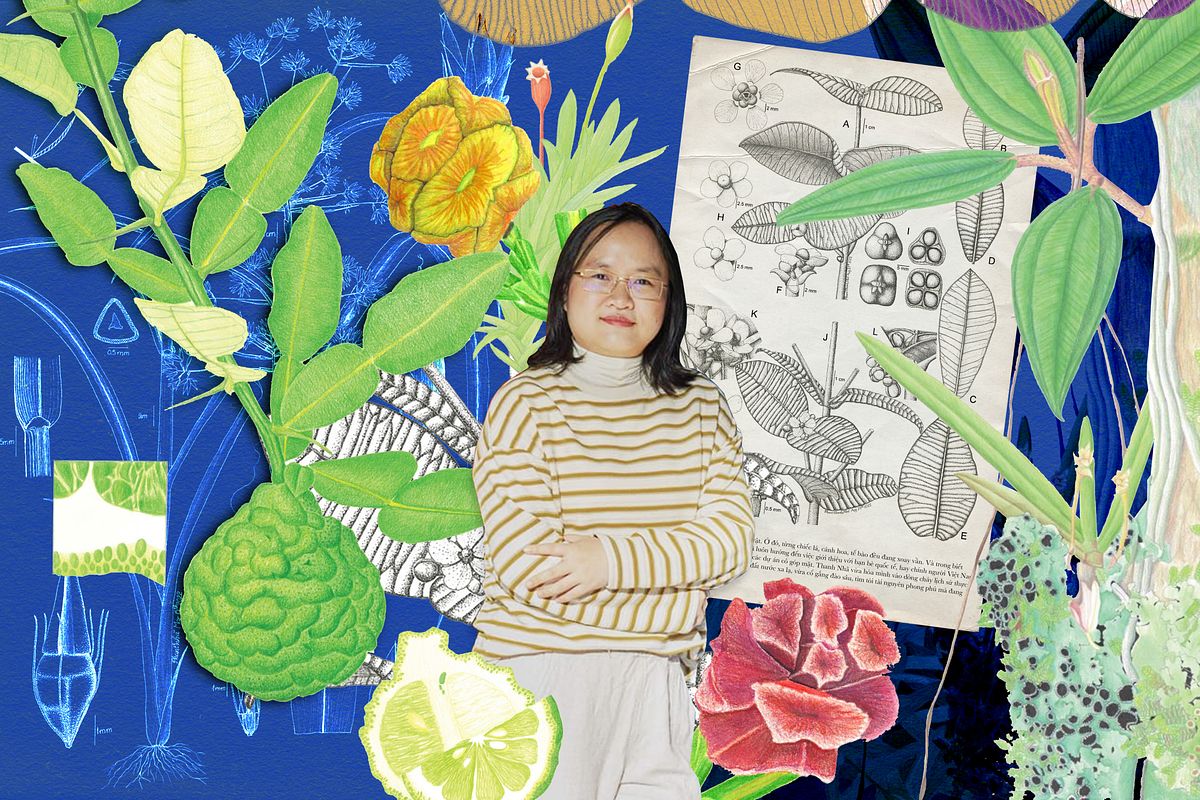When science and art commingle in a botanical illustration, it’s as if a magical world appears, where colors, brushstrokes, and lighting work together to not only replicate but also breathe life into nature’s best creations.
Phan Thị Thanh Nhã is a botanist by trade, working as a teaching assistant at the Botany Lab of the Faculty of Biology-Biotechnology at the University of Science, HCMC Vietnam National University. Interestingly, she is also the author behind all the illustrations in her botanical research.

Phan Thị Thanh Nhã at the exhibition “Fields of Optics | Chapter I: Biocenosis”
Nhã embarked on her journey with botanical illustration, a relatively new and challenging field in Vietnam, thanks to previous works by Professor Phạm Hoàng Hộ, including two iconic books Cây cỏ Việt Nam (The Flora of Vietnam) and Hiển hoa bí tử (Flowering Plants). She was the first artist in the field from Vietnam whose art pieces were featured internationally, at the “Flora of Southeast Asia” exhibition in September 2022. The success of the event helped consolidate Nhã’s faith in her craft, making her realize that there’s a space in botanical illustration for young enthusiasts like her, as long as they approach it seriously and with an open mind.

Rhynchospora corymbosa (L.) Britton | Chủy tử tản phòng | Golden beaksedge
Into the world of native flora
Nhã is pursuing different forms of scientific illustration, but her focus is on botanical illustration and botanical art. The former places emphasis on scientific utility and perspective; the latter, while still scientifically accurate, can concentrate on aesthetic appeal instead.
A botanical illustration is a faithful depiction of a species, often used in scientific documents, textbooks, and research publications. Artworks in this genre require a high level of accuracy when it comes to detailing every part of the plant. These visual portrayals, alongside in-depth description texts, will provide readers with a comprehensive profile about the species in question.

Garcinia phuongmaiensis V.S.Dang, H.Toyama & D.L.A.Tuan | Bứa Phương Mai | Exhibition: “Margaret Flockton Award 2023”
Botanical art, on the other hand, aims to blend the precision of botany with the emotional appeal of visual art. It’s still rooted in scientific specifications, but instead of showing every part and life stage of the plant, the artist can choose to zoom in on a leaf or a flower. As long as the work is botanically accurate, the author is free to experiment with composition, lighting, or even emotional narrative to help the species stand out.

Camellia honbaensis Luu, Q.D.Nguyen & G.Tran | Trà mi Hòn Bà.
“Each species has its own scientific name in Latin,” she explained. Before starting any illustration, Nhã must seek out its scientific name and read all related documents, such as the plant’s medicinal properties, natural distribution, and usage. In learning comprehensively about the species, she arrives at the most complete picture to start sketching.
The final work is a team effort
Once an initial sketch is done, she will send it to the leading experts of each plant family or order to get their feedback, and discuss with them how to adjust the illustration.

Camellia yokdonensis Dung bis & Hakoda | Trà mi Yok Đôn.
“For instance, when I was creating a piece on the Yok Đôn camellia flower, the researchers suggested I modify the flower to face upwards, and informed me about its two color variants: vibrant orange and gentle pink,” Nhã recalled. “After our discussion, they recommended I depict the pink variant to appeal to viewers’ taste, so they could feel connected to it and maybe will seek it out to plant at home.”
Still, accuracy is a high priority for her artworks, as each fold and vein of the leaves must be replicated correctly. The experts not only weigh in to help correct the sketch but also provide her with ample references on the plant’s visual appearance, medicinal use, and biological attributes so she could best bring the plant to life on paper.

Calophyllum inophyllum L. | Mù u.
Picking the right medium for the illustrations is also a crucial step. Each plant species carries with it a distinctive elegance, angularity or movement, so the material to execute their portrayal should also fit those characteristics. Colored pencils and watercolor are most commonly used to depict flowers. Rhizomes like ginger relatives tend to be sharper, so she usually picks acrylic. Besides, silk painting is another possible choice for botanical illustrations.
A piece of botanical illustration is often highly valuable, not just due to material costs, but also because of the effort and time spent completing it. The creative part does require a high level of focus, but to Nhã, the most challenging step involves getting feedback from the experts and then modifying each small detail based on the comments so that the plant appears most accurately. Some illustrations, because of that, might take years to finish.
Loving means understanding
It’s Nhã’s hope to transform seemingly complicated science into something approachable to everyone, so they can better understand the flowers, trees and fruits of their nation. She believes that only by really understanding something can we grow to love it; and once we love it, we’ll spend efforts to preserve and protect it, and to cultivate it in order to prolong its existence on Earth. One of the methods of plant conservation that she tries to promote is ex situ conservation — protecting species outside of their natural habitat.

Inside the “Scent Station” workshop.
Nhã has been doing her part to connect and expand the community of plant aficionados through many initiatives, from organizing workshops to hands-on programs to give people a chance to get to know Vietnam’s amazing botanical diversity.
Starting from October 2023, Nhã commenced a series of events providing multi-sensory experiences revolving around botanical illustration, including “Botanical Art: Ways of Seeing” (visual), “Botanical Art: Scent Station” (olfactory), and “From Palette to Palate” (gustatory), and tactile experiences via a collaboration with a fashion organization in Saigon.

Common household spices of Vietnam as seen in Scent Station.
During the olfactory workshop, Nhã presented a collection of essential oils and introduced oil extraction methods while providing cautions on how to use them to guests. Various nuggets of specialized knowledge from fields like organic chemistry and plant anatomy were peppered throughout the event in accessible and educational ways. Participants had an opportunity to explore the oils with four senses: observing the physical state of the oils and viewing illustrations of the plants that produce them, listening to the background information, feeling the sensations of some skin-safe oils like mù u, passion fruit, and sachi on their hands, and smelling them.
In 2024, she also organized events focusing on sketching and exploring the plant world with children, students, and senior participants. To join, one does not need to know how to draw or have any botany knowledge, because Nhã believes that anyone can pick up a pencil to draw and get closer to the universe of botanical illustration.
Each artwork reflects the soul
The time spent working closely with plants is when Nhã feels the most connected to nature in a wholesome way. It’s not simply replicating the silhouettes of a leaf or a petal, but embodying their truest soul on paper via an in-depth understanding.

Neptunia oleracea Lour. | Rau nhút.
Spending time with plants is also a journey of self-discovery. The illustrator can hone their fingers’ nimbleness and sharpen their observational skills, but most importantly, learn how to listen to their body. With every brushstroke, they could reduce stress, be in tune with the rhythm of their breaths, practice mindfulness, and marvel at the beauty of nature.
The world of plants is expansive where each leaf, each cell is constantly living. Through her work in botanical illustration, Nhã has a front seat to witness those pulses of life while unearthing the eclectic natural treasures in the familiar world around her.
















